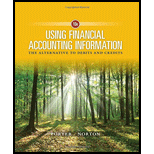
Using Financial Accounting Information
10th Edition
ISBN: 9781337276337
Author: Porter, Gary A.
Publisher: Cengage Learning,
expand_more
expand_more
format_list_bulleted
Question
Chapter 1, Problem 1.8E
To determine
Concept Introduction:
Financial statements are summarized financial information of a particular period. A set of financial statements include
To identify: the type of financial statement and account.
Expert Solution & Answer
Want to see the full answer?
Check out a sample textbook solution
Students have asked these similar questions
Can you explain the correct approach to solve this general accounting question?
What is the profit margin? Give me fast answer please
Solve the problem
Chapter 1 Solutions
Using Financial Accounting Information
Ch. 1 - Prob. 1.1ECh. 1 - Prob. 1.2ECh. 1 - Prob. 1.3ECh. 1 - Prob. 1.4.1ECh. 1 - Prob. 1.4.2ECh. 1 - Prob. 1.4.3ECh. 1 - Prob. 1.4.4ECh. 1 - Prob. 1.5.1ECh. 1 - Prob. 1.5.2ECh. 1 - Prob. 1.5.3E
Ch. 1 - Changes in Owners’ Equity The following amounts...Ch. 1 - Prob. 1.6.2ECh. 1 - Prob. 1.6.3ECh. 1 - Prob. 1.7ECh. 1 - Prob. 1.8ECh. 1 - Prob. 1.9ECh. 1 - Prob. 1.10.1ECh. 1 - Prob. 1.10.2ECh. 1 - Prob. 1.10.3ECh. 1 - Prob. 1.10.4ECh. 1 - Prob. 1.10.5ECh. 1 - Prob. 1.10.6ECh. 1 - Prob. 1.11ECh. 1 - Prob. 1.12ECh. 1 - Prob. 1.13ECh. 1 - Prob. 1.14ECh. 1 - Prob. 1.15MCECh. 1 - Prob. 1.16MCECh. 1 - Prob. 1.1PCh. 1 - Prob. 1.2PCh. 1 - Prob. 1.3PCh. 1 - Prob. 1.4.1PCh. 1 - Prob. 1.4.2PCh. 1 - Prob. 1.5.1PCh. 1 - Prob. 1.5.2PCh. 1 - Prob. 1.5.3PCh. 1 - Prob. 1.5.4PCh. 1 - Prob. 1.6.1PCh. 1 - Prob. 1.6.2PCh. 1 - Income Statement and Balance Sheet Green Bay...Ch. 1 - Prob. 1.7.1PCh. 1 - Prob. 1.7.2PCh. 1 - Prob. 1.7.3PCh. 1 - Prob. 1.7.4PCh. 1 - Prob. 1.8.1PCh. 1 - Prob. 1.8.2PCh. 1 - Prob. 1.9PCh. 1 - Prob. 1.10MCPCh. 1 - Prob. 1.1AAPCh. 1 - Prob. 1.2AAPCh. 1 - Prob. 1.3AAPCh. 1 - Prob. 1.4AAPCh. 1 - Prob. 1.5AAPCh. 1 - Prob. 1.5.1AAPCh. 1 - Prob. 1.5.2AAPCh. 1 - Prob. 1.5.3AAPCh. 1 - Prob. 1.5.4AAPCh. 1 - Prob. 1.6.1AAPCh. 1 - Prob. 1.6.2AAPCh. 1 - Prob. 1.6.3AAPCh. 1 - Prob. 1.7.1AAPCh. 1 - Prob. 1.7.2AAPCh. 1 - Prob. 1.7.3AAPCh. 1 - Prob. 1.7.4AAPCh. 1 - Prob. 1.8.1AAPCh. 1 - Prob. 1.8.2AAPCh. 1 - Prob. 1.9AAPCh. 1 - Prob. 1.10AAMCP
Knowledge Booster
Learn more about
Need a deep-dive on the concept behind this application? Look no further. Learn more about this topic, accounting and related others by exploring similar questions and additional content below.Similar questions
arrow_back_ios
SEE MORE QUESTIONS
arrow_forward_ios
Recommended textbooks for you
 Financial Accounting: The Impact on Decision Make...AccountingISBN:9781305654174Author:Gary A. Porter, Curtis L. NortonPublisher:Cengage Learning
Financial Accounting: The Impact on Decision Make...AccountingISBN:9781305654174Author:Gary A. Porter, Curtis L. NortonPublisher:Cengage Learning College Accounting (Book Only): A Career ApproachAccountingISBN:9781337280570Author:Scott, Cathy J.Publisher:South-Western College Pub
College Accounting (Book Only): A Career ApproachAccountingISBN:9781337280570Author:Scott, Cathy J.Publisher:South-Western College Pub Intermediate Accounting: Reporting And AnalysisAccountingISBN:9781337788281Author:James M. Wahlen, Jefferson P. Jones, Donald PagachPublisher:Cengage Learning
Intermediate Accounting: Reporting And AnalysisAccountingISBN:9781337788281Author:James M. Wahlen, Jefferson P. Jones, Donald PagachPublisher:Cengage Learning College Accounting, Chapters 1-27AccountingISBN:9781337794756Author:HEINTZ, James A.Publisher:Cengage Learning,Principles of Accounting Volume 1AccountingISBN:9781947172685Author:OpenStaxPublisher:OpenStax College
College Accounting, Chapters 1-27AccountingISBN:9781337794756Author:HEINTZ, James A.Publisher:Cengage Learning,Principles of Accounting Volume 1AccountingISBN:9781947172685Author:OpenStaxPublisher:OpenStax College

Financial Accounting: The Impact on Decision Make...
Accounting
ISBN:9781305654174
Author:Gary A. Porter, Curtis L. Norton
Publisher:Cengage Learning


College Accounting (Book Only): A Career Approach
Accounting
ISBN:9781337280570
Author:Scott, Cathy J.
Publisher:South-Western College Pub

Intermediate Accounting: Reporting And Analysis
Accounting
ISBN:9781337788281
Author:James M. Wahlen, Jefferson P. Jones, Donald Pagach
Publisher:Cengage Learning

College Accounting, Chapters 1-27
Accounting
ISBN:9781337794756
Author:HEINTZ, James A.
Publisher:Cengage Learning,

Principles of Accounting Volume 1
Accounting
ISBN:9781947172685
Author:OpenStax
Publisher:OpenStax College
ACCOUNTING BASICS: Debits and Credits Explained; Author: Accounting Stuff;https://www.youtube.com/watch?v=VhwZ9t2b3Zk;License: Standard Youtube License